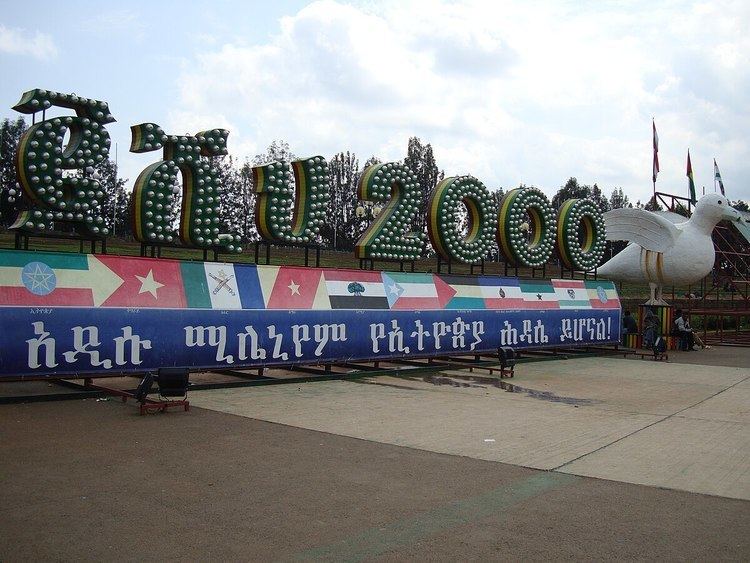 | ||
Sign languages several local sign languages | ||
The languages of Ethiopia refers to the various spoken forms of communication in Ethiopia. It includes the nation's official languages, as well as its minority and foreign languages.
Contents
Map of Ethiopia
Overview
There are 88 individual languages of Ethiopia according to Ethnologue, with the 1994 Ethiopian census indicating that some 77 tongues were spoken locally. Most of these languages belong to the Afroasiatic family (Semitic and Cushitic languages; Omotic languages are also spoken, though their classification is uncertain). Additionally, Nilo-Saharan languages are spoken by the nation's minority Nilotic peoples.
Of the languages spoken in Ethiopia, 86 are living and 2 are extinct. 41 of the living languages are institutional, 14 are developing, 18 are vigorous, 8 are in danger of extinction, and 5 are near extinction.
Charles A. Ferguson proposed the Ethiopian language area, characterized by shared grammatical and phonological features in 1976. This sprachbund includes the Afroasiatic languages of Ethiopia, not the Nilo-Saharan languages. In 2000, Mauro Tosco questioned the validity of Ferguson's original proposal. There is still no agreement among scholars on this point, but Tosco has at least weakened Ferguson's original claim.
English is the most widely spoken foreign language and is the medium of instruction in secondary schools and universities. Amharic was the language of primary school instruction but has been replaced in many areas by local languages such as Oromo and Tigrinya.
After the fall of the Derg in 1991, the 1995 Constitution of Ethiopia granted all ethnic groups the right to develop their languages and to establish first language primary education systems. This is a marked change to the language policies of previous governments in Ethiopia.
In terms of writing systems, Ethiopia's principal orthography is the Ge'ez script. Employed as an abugida for several of the country's languages, it first came into usage in the sixth and fifth centuries BC as an abjad to transcribe the Semitic Ge'ez language. Ge'ez now serves as the liturgical language of the Ethiopian and Eritrean Orthodox Tewahedo Churches. Other writing systems have also been used over the years by different Ethiopian communities. These include Arabic script for writing some Ethiopian languages spoken by Muslim populations and Sheikh Bakri Sapalo's script for Oromo. Today, many Cushitic, Omotic, and Nilo-Saharan languages are written in Roman/Latin script.
Languages
According to the 2007 Ethiopian census, the largest first languages are: Amharic 21,634,396 or 29.30%;Oromo language 24,930,424 speakers or 33.80% of the total population Somali 4,609,274 or 6.25%; Tigrinya 4,324,476 or 5.86% Sidamo 2,981,471 or 4.84% Wolaytta 1,627,784 or 2.21%; Gurage 1,481,783 or 2.01% and Afar 1,281,278 or 1.74% Widely spoken foreign languages include English (major foreign language taught in schools), Arabic and Italian. Amharic is the official language in which all federal laws are published, and it is spoken by millions of Ethiopians as a second language. In most regions it is the primary second language in the school curriculum.
Afroasiatic
Afroasiatic
Nilo-Saharan
In Ethiopia, the term "Nilotic" is often used to refer to Nilo-Saharan languages and their communities. However, in academic linguistics, "Nilotic" is only part of "Nilo-Saharan", a segment of the larger Nilo-Saharan family.
Nilo-Saharan
Unclassified
Endangered languages
A number of Ethiopian languages are endangered: they may not be spoken in one or two generations and may become extinct, victims of language death, as Weyto, Gafat, and Mesmes have and Ongota very soon will. The factors that contribute to language death are complex, so it is not easy to estimate which or how many languages are most vulnerable. Hudson wrote, "Assuming that a language with fewer than 10,000 speakers is endangered, or likely to become extinct within a generation", there are 22 endangered languages in Ethiopia (1999:96). However, a number of Ethiopian languages never have had populations even that high, so it is not clear that this is an appropriate way to calculate the number of endangered languages in Ethiopia. The real number may be lower or higher. The new language policies after the 1991 revolution have strengthened the use of a number of languages. Publications specifically about endangered languages in Ethiopia include: Appleyard (1998), Hayward (1988), Zelealem (1998a,b, 2004)
